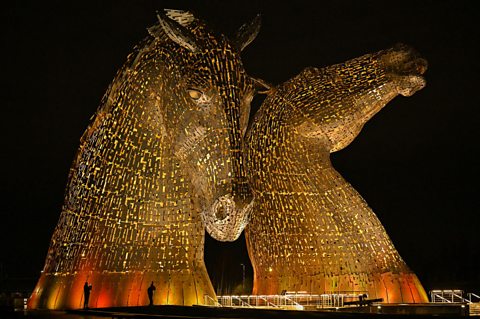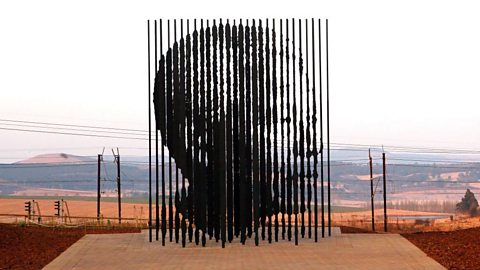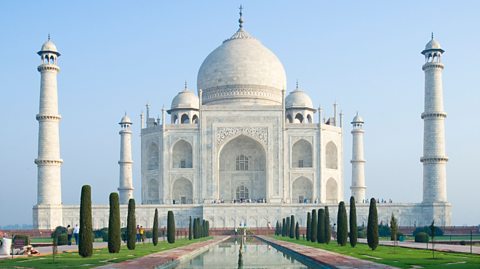From the gigantic to the tiny, the beautiful to the bleak, the world is full of awe-inspiring sculptures.
Frequently found in public spaces, not just art galleries, you can often get close enough to a sculpture to touch it or walk around it. Artists love to play with this interaction, creating sculptures that look different from various angles or which serve a specific purpose.
±«Óătv Bitesize has taken a look at some of the world’s most incredible sculptures and the stories behind them.
 Image source, Muhammad Qadeer
Image source, Muhammad QadeerJatayu Earth's Center, India
Within the Jatayu Nature Park, in the Indian state of Kerala, lies a magnificent bird sculpture. A claw reaches towards the sky, while the expansive wings sweep down towards the ground, forming the roof of the Jatayu Earth Center below.
Around 61m (200 feet) long, 46m (150 feet) wide and 21m (70 feet) tall, this is the largest sculpture of a bird anywhere in the world.
It represents the Hindu demi-god Jatayu, who features in the epic poem Ramayana and takes the form of a vulture. The epic tells of how he attempted to rescue Sita, the wife of Raman (the Hindu god Vishnu in a human form), from being kidnapped by the demon king Ravana. But Jatayu is defeated after Ravana is able to damage his wing. The story of Ramayana is celebrated every year during the festival of Diwali.
The sculpture was designed by Rajiv Anchal, who is also a film director, and was opened in August 2018.
 Image source, Muhammad Qadeer
Image source, Muhammad Qadeer Image source, Jeff J Mitchell
Image source, Jeff J MitchellThe Kelpies, Scotland
Another impressively large animal sculpture is Andy Scott’s The Kelpies. Kelpies are a mythical water horse from Scottish folklore, who live in lochs and rivers, but these horseheads have much more grounded origins. The inspiration came from the sturdy work horses who pulled barges up and down Scotland’s canal system, helping to transport goods and materials.
Sat alongside the Forth and Clyde Canal near Falkirk, these equine sculptures welcome anyone travelling into Scotland through the River Carron from the direction of the North Sea. They can also be clearly seen from the M8 motorway.
Each of the Kelpies stands 30m (100 feet) tall and weighs over 300 tonnes. In order to support that kind of weight, 30m deep foundations were required. The shape of each sculpture was created by attaching hundreds of steel plates to a skeleton structure. Scott refined his design by initially creating miniature versions of the final sculpture, which were then scanned to create a 3D computer model.
The Kelpies were officially opened by Princess Anne on 8 July 2015, alongside the Clydesdale horses who had acted as models.
The Silent Evolution, Mexico
To see this sculpture in person you’ll need to dive below the waters of Mexico’s Cancún Underwater Museum (Museo Subacuático de Arte). Created by Jason deCaires Taylor, this underwater installation was deliberately designed to become an artificial coral reef, benefiting the local ecosystem and helping to draw snorkelers and divers away from nearby natural reefs which were coming under pressure.
Weighing over 120 tonnes, the sculpture is made up of 400 life-sized statues of ordinary people from the local community. They are made from a particular type of cement which has a neutral ​​Scale of acidity or alkalinity. A pH (power of hydrogen) value below 7 is acidic, a pH value above 7 is alkaline., providing favourable conditions for coral growth. It’s also much harder than standard cement and so will not quickly erode away.
The natural crevices formed by the shape of human bodies are ideal for reef creatures to dwell in or latch onto, and the sculpture’s location downstream of other reefs means that they are perfectly placed to intercept the drifting fertilised eggs of coral spawn.
 Image source, RAJESH JANTILAL
Image source, RAJESH JANTILALRelease, South Africa
For Marco Cianfanelli’s sculpture of South Africa’s first black president and famous freedom fighter, Nelson Mandela, location was just as important as the look.
It sits just outside a small town called Howick in South Africa, on a road called the R103. It was down this road on 5 August 1962, that Nelson Mandela was travelling in a car when he was flagged down by police and arrested. Sentenced to life imprisonment, Mandela would spend 27 years in various prisons before eventually being freed in 1990. Three years later, he was awarded the Nobel Peace Prize.
This sculpture was unveiled in 2012 to mark 50 years since Mandela’s arrest. Cianfanelli incorporated the anniversary into the design itself, using 50 steel poles of differing heights to represent the prison. These columns deliberately have notched edges so that their shape changes when viewed from different positions. Find the right spot and you’ll clearly be able to see Mandela’s head.
Horizons, New Zealand
Commissioned by the Gibbs Farm outdoor sculpture collection in Auckland, New Zealand, Neil Dawson’s sculpture playfully uses perspective to make it seem like a giant piece of material has been blown along by the wind and landed on top of a hill.
In fact, it is made of painted steel welded together and is 15m tall (50 feet) and 36m (118 feet) long.
This sculpture is typical of Dawson’s whimsical style, using illusions to create effect. It almost looks like a cartoon has come to life on the horizon.
This article was published in February 2022.
The Bitesize art movements quiz
Who was that Pop Art hero? And which famous name helped create Cubism?

Five artists who popped up in their own creations
Have you spotted these painters, authors and film-makers in their own works?

The Seven Wonders of the World quiz
From the ancient to the modern, how much do you know about these famous landmarks?
